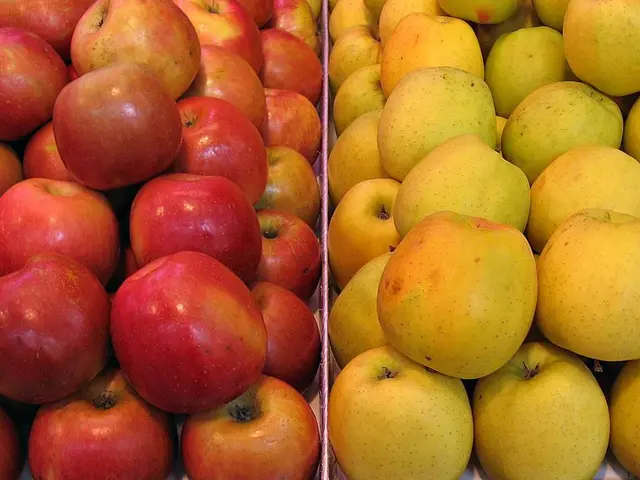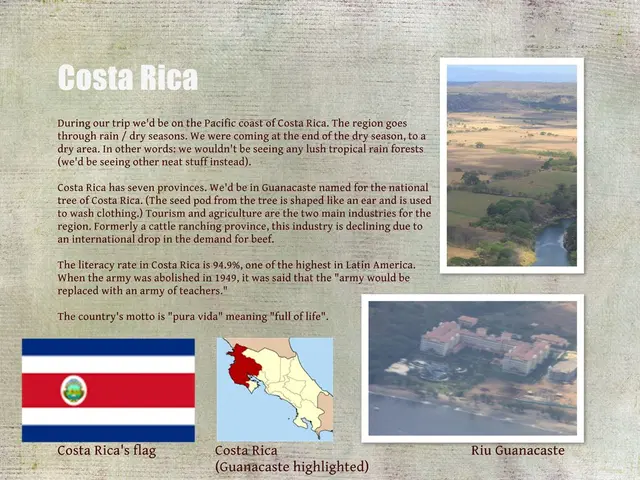Delving into the Mediterranean Diet: A Blend of Cultures in One Meal
When you think "Mediterranean Diet," what springs to mind? Perhaps visions of rolling olive groves in Spain, vibrant spice markets in Morocco, or sunlit vineyards in Italy. But the Mediterranean Diet is more than just a collection of delicious cuisines; it's a lively fusion of cultures and tastes that have interactively formed a globally renowned culinary tradition.
A Hotspot of Cultures
The Mediterranean region has always served as a crossroads for civilizations. Its history boasts the rise and fall of great powers - the Egyptians, Greeks, Romans, Byzantines, and Ottomans, to name a few. Each left a unique mark on the area's gastronomy.
The Influences of Antiquity
In ancient times, trade routes crisscrossed the Mediterranean, bringing spices from the East, grains from Egypt, and olives and wine from Greece and Rome. The Phoenicians, skilled sailors, played a part in the dispersal of ingredients like olives and grapes. Concurrently, the ancient Greeks introduced the world to a diet founded on simplicity - bread, wine, and olive oil, the fundamental building blocks of today's Mediterranean Diet.
The Middle Ages: A Melting Pot of Flavors
The Middle Ages unveiled the emergence of the Islamic Empire, which extended from the Middle East to Spain. The Arabs ushered in ingredients such as oranges, saffron, and rice, which became mainstream components of Mediterranean cuisine. The region was a melting pot, where ideas and ingredients mingled, adapted, and blended.
Core Components of the Mediterranean Diet
Olive Oil: The Golden Essence
At the heartbeat of the diet lies olive oil, often referred to as "liquid gold." This versatile oil is not merely a cooking medium; it's a cultural emblem deep-rooted in the Mediterranean lifestyle. Olive oil lends its unique flavor to everything from salads to sauces and offers a myriad of health advantages.
Seafood: The Bounty of the Coast
With its vast coastlines, it's no wonder seafood is a diet staple. From humble sardines to opulent lobster, Mediterranean cuisine leverages the sea's bounty. Preparations often involve simple ingredients like lemon, herbs, and, of course, olive oil.
Fresh Produce: Nature's Palette
The Mediterranean climate, with its abundant sunshine, yields an array of fruits and vegetables. Tomatoes, eggplants, cucumbers, and leafy greens are not just sides; they provide the foundation for many dishes. Seasonality is crucial, with meals centered around what's fresh and ripe.
Grains and Legumes: The Old World Standbys
Grains, particularly wheat, have been a Mediterranean mainstay for millennia. Bread, pasta, and couscous form the bases for numerous meals. Legumes like lentils, chickpeas, and beans are also integral, offering nutrients like protein and fiber.
Dairy Delights: Cheese and Yogurt
From familiar Greek feta to Italian Parmesan, cheese is another cornerstone of Mediterranean cuisine. Yogurt, too, is a staple, particularly in the Middle Eastern and North African regions of the Mediterranean. These dairy products are often produced from goat's or sheep's milk, well-suited to the terrain.
Health Benefits: More Than Just Food
The Mediterranean Diet is acclaimed not just for its mouth-watering flavors but also for its health advantages. Rich in heart-healthy fats, whole grains, and antioxidants, it's been linked to reduced risks of heart disease, diabetes, and other chronic conditions. It embodies a philosophy that emphasizes balance and moderation, mirroring the Mediterranean approach to eating as a pleasurable, social activity.
The Cultural Exchange Continues
Modern transportation and technology have facilitated the sharing of ingredients and recipes across borders. But the essence of the diet endures - a focus on fresh, local ingredients, prepared in ways that accentuate their natural flavors and nutritional value.
Shaping Flavors: The Impact of Geography and Climate
Cultural Landmarks
The Mediterranean's geography and climate have played a significant role in molding its cuisine. The warm, sunny environment favors the cultivation of a wide variety of fruits and vegetables, while the rugged terrain in some areas favors hardy crops like olives and grapes. The sea influences coastal diets notably.
Distinct Regional Styles
Even though there is a common thread running through Mediterranean cuisine, regional variations are discernible. For example, North African Mediterranean cooking features stronger flavors with the use of spices like cumin and coriander, reflecting its Arab and Berber influences. In contrast, the European side tilts more towards herbs like rosemary and thyme.
Food as a Way of Life: The Social Aspect
Meals as Social Events
In Mediterranean cultures, meals transcend mere sustenance, serving as social gatherings. Families and friends gather around the table, savoring dishes and conversations. This social element is a pivotal part of the diet's appeal and longevity.
A Slow Food Movement
This emphasis on savoring food in the company of others aligns with the Slow Food movement, which originated in Italy as a counter to fast food. It advocates for local, traditional food practices and ingredients, echoing the Mediterranean Diet's values.
Modern Fusion and Evolution: Mediterranean Cuisine Today
The Contemporary Blend
In today's globalized world, Mediterranean cuisine continues to evolve. Chefs and home cooks alike marry traditional Mediterranean ingredients with contemporary techniques and flavors from around the world, creating a contemporary fusion that preserves the diet's roots.
A Sustainable Eating Model
The Mediterranean Diet is also being considered as a model for sustainable eating. Its emphasis on plant-based foods, local sourcing, and seasonal eating aligns with current ideas about lessening our environmental impact and eating healthier.
Cultural Significance: Beyond the Plate
A Reflection of History and Tradition
The Mediterranean's food is a mirror of the region's rich history and cultural traditions. From the olive oil that has been a staple for millennia to the relatively recent incorporation of tomatoes from the New World, the cuisine embodies a story of trade, conquest, and cultural exchange.
The Preservation of Heritage
There's now an increased movement to conserve traditional Mediterranean gastronomic practices. This not only helps maintain cultural heritage but also ensures the preservation of the region's biodiversity and ecological balance.
The Takeaway
The Mediterranean Diet is a captivating demonstration of how food extends beyond mere nourishment. It represents a harmonious blend of cultures, a testament to the region's rich history, and a standard for sustainable and healthy living. Embracing the Mediterranean eating style, we partake in a culinary heritage that is both ancient and continually evolving, nourishing our bodies as well as our souls.
- The Mediterranean region, a hotspot of cultures, has been shaped by the rise and fall of great powers such as the Egyptians, Greeks, Romans, Byzantines, and Ottomans, each leaving a unique influence on the area's gastronomy.
- In antiquity, trade routes crisscrossed the Mediterranean, bringing ingredients like spices from the East, grains from Egypt, and olives and wine from Greece and Rome, introducing the world to a diet founded on simplicity.
- During the Middle Ages, the Arab Empire introduced ingredients such as oranges, saffron, and rice, which became mainstream components of Mediterranean cuisine, transforming it into a melting pot of flavors.
- The core components of the Mediterranean Diet include olive oil, seafood, fresh produce, grains and legumes, and dairy delights like cheese and yogurt, each playing a significant role in the region's culinary tradition.
- The diet is celebrated not just for its mouth-watering flavors but also for its health advantages, being linked to reduced risks of heart disease, diabetes, and other chronic conditions, embodying a philosophy that emphasizes balance, moderation, and enjoying food in the company of others.








